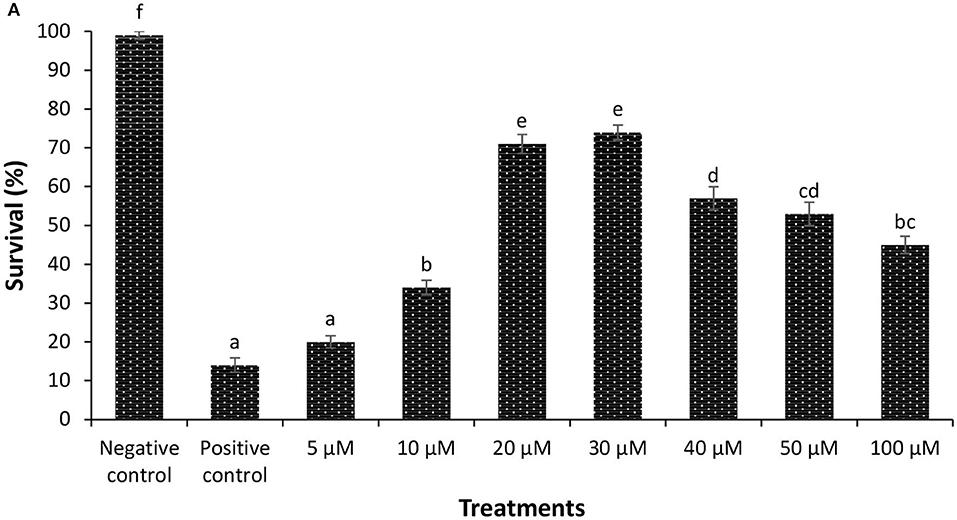
94% of researchers rate our articles as excellent or good
Learn more about the work of our research integrity team to safeguard the quality of each article we publish.
Find out more
CORRECTION article
Front. Immunol. , 18 August 2020
Sec. Comparative Immunology
Volume 11 - 2020 | https://doi.org/10.3389/fimmu.2020.01860
This article is a correction to:
Phloroglucinol-Mediated Hsp70 Production in Crustaceans: Protection against Vibrio parahaemolyticus in Artemia franciscana and Macrobrachium rosenbergii
A Corrigendum on
Phloroglucinol-Mediated Hsp70 Production in Crustaceans: Protection against Vibrio parahaemolyticus in Artemia franciscana and Macrobrachium rosenbergii
by Kumar, V., Baruah, K., Nguyen, D. V., Smagghe, G., Vossen, E., and Bossier, P. (2018). Front. Immunol. 9:1091. 10.3389/fimmu.2018.01091
In the original article, there was a mistake in Figure 1A as published. We have recently discovered that incorrect brine shrimp survival data at different phloroglucinol doses were presented in the published paper. The corrected Figure 1A appears below.

Figure 1. (A) Survival (%) of phloroglucinol-pretreated brine shrimp larvae after 48 h of challenge with V. parahaemolyticus MO904. The larvae were pretreated with phloroglucinol at the indicated doses for 2 h, rinsed to wash away the compound, and then allowed to recover for 2 h. The larvae were subsequently challenged with V. parahaemolyticus at 107 cells/ml of rearing water. Non-pretreated larvae that were either challenged with V. parahaemolyticus (positive control) or unchallenged (negative control) served as controls. Error bars represent the standard error of five replicates; different letters indicate significant differences (P < 0.001).
The authors apologize for this error and state that this does not change the scientific conclusions of the article in any way. The original article has been updated.
Keywords: gnotobiotic Artemia, Vibrio parahaemolyticus, phloroglucinol, heat shock protein 70, Macrobrachium rosenbergii
Citation: Kumar V, Baruah K, Nguyen DV, Smagghe G, Vossen E and Bossier P (2020) Corrigendum: Phloroglucinol-Mediated Hsp70 Production in Crustaceans: Protection against Vibrio parahaemolyticus in Artemia franciscana and Macrobrachium rosenbergii. Front. Immunol. 11:1860. doi: 10.3389/fimmu.2020.01860
Received: 21 June 2020; Accepted: 10 July 2020;
Published: 18 August 2020.
Edited and reviewed by: Chu-Fang Lo, Center for Shrimp Disease Control and Genetic Improvement, National Cheng Kung University, Taiwan
Copyright © 2020 Kumar, Baruah, Nguyen, Smagghe, Vossen and Bossier. This is an open-access article distributed under the terms of the Creative Commons Attribution License (CC BY). The use, distribution or reproduction in other forums is permitted, provided the original author(s) and the copyright owner(s) are credited and that the original publication in this journal is cited, in accordance with accepted academic practice. No use, distribution or reproduction is permitted which does not comply with these terms.
*Correspondence: Kartik Baruah, a2FydGlrLmJhcnVhaEBzbHUuc2U=
†Present address: Kartik Baruah, Department of Animal Nutrition and Management, Faculty of Veterinary Medicine and Animal Sciences, Swedish University of Agricultural Sciences, Uppsala, Sweden
Disclaimer: All claims expressed in this article are solely those of the authors and do not necessarily represent those of their affiliated organizations, or those of the publisher, the editors and the reviewers. Any product that may be evaluated in this article or claim that may be made by its manufacturer is not guaranteed or endorsed by the publisher.
Research integrity at Frontiers

Learn more about the work of our research integrity team to safeguard the quality of each article we publish.